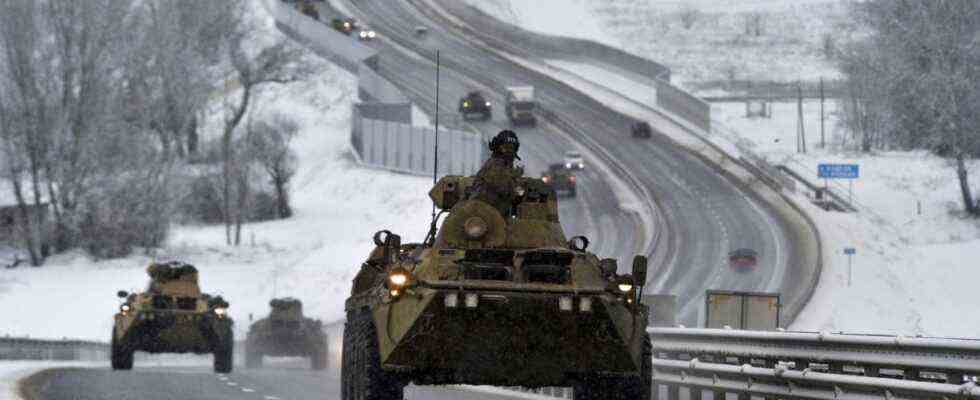Western secret services are convinced that Russia has used the past few weeks to further strengthen its troops on the borders of Ukraine and to build up military options. “We assume that more than a third of the combat-ready Russian ground forces are there,” a senior military expert said Süddeutsche Zeitung. He put the number of soldiers at 106,000; this does not include members of the navy or air force, nor the armed forces of the Moscow-controlled separatists in Donbass. Western secret services put these numbers at 35,000 to 40,000 men.
The situation in Ukraine is “worrying” and “very challenging” given Russia’s military superiority. Between 55 and 60 tactical battalion groups (BTG) are currently stationed less than 300 kilometers from the Ukrainian border. In the Russian military, this is the name given to the smallest unit that can independently conduct combat. Depending on the specialization, it consists of 400 to 800 soldiers, plus units for support and logistics.
As of February 2021, at most 25 of these entities were present in the same area. According to Western military experts, this was sufficient to defend Crimea, the Russian areas along the border and also the separatist republics in eastern Ukraine. During a first troop deployment in April, Moscow had assembled 35 to 40 BTGs, and in mid-December the number was almost 50.
“We last saw such Russian troop transfers from the Far East to Ukraine in 1941,” says a secret service agent
Other battalion groups are being moved west across the country from the Eastern Military District. “The last time we saw such a transfer from the Far East to Ukraine was in 1941,” says a secret service agent. Should the Russian troops invade Ukraine as a whole, the greatest fighting in Europe since the Second World War can be expected.
While artillery, rockets and combat units and their support troops were mainly deployed in the fall, Russia has been sending supplies of ammunition and material for field hospitals, but also border guards, units of the National Guard and reservists with police experience to Ukraine since the end of December. Such forces are necessary if one wants to occupy territories.
The Ukrainian military totals about 190,000 soldiers. 45,000 of them, a good half of the land forces, are tied to the line of contact with the separatist republics in the east. In addition to the numerical inferiority, according to Western military experts, Ukraine lacks an effective air defense system. The Russian air force could therefore prepare a ground offensive with massive bombardment. Russia has also deployed 36 rocket launchers within range of Ukrainian territory Iskander-Can fire short-range missiles with a nominal range of 500 kilometers.
The troop deployment offers Russian President Vladimir Putin a number of military options. The most comprehensive would be an invasion on several fronts, others the annexation of the separatist republics or the attempt to militarily free a land bridge to Crimea from there. “I believe that very few people close to him know what Putin is thinking and will ultimately decide,” said a senior intelligence official.
The most threatening scenario: a Russian attack on three fronts
The intelligence services are concerned that Russia could attack on three fronts. At the beginning of 2021, troop movements were mainly seen in eastern Ukraine, near Rostov-on-Don and Voronezh. These cities are behind the separatist republics of Donetsk and Lugansk. Now more soldiers would be transferred to the Belgorod and Kursk districts, which are close to the border with Belarus. Its ruler Alexander Lukashenko is completely dependent on Putin.
Joint maneuvers that Russia and Belarus have announced for February will involve infantry and special forces suitable for an invasion. Another 16 BTG could be used here. In the Baltic States and in Poland, there is great concern that these will remain. Also, Russia relocates modern ones S-400-Anti-aircraft batteries and twelve Sukhoi Su-35– Fighter jets to Belarus. An attack on this flank could target areas along the Dnieper River and the capital, Kiev. “For the Ukrainians, the northern front they have to defend actually extends from Lugansk to Poland,” says the secret service official.
The situation in the south is similarly difficult. From Crimea, which Russia annexed in 2014, Russian soldiers could advance towards the city of Odessa and launch an amphibious operation to completely cut off Ukraine from the Black Sea. “The Russians are already able to do that today,” says the secret service agent. However, this scenario becomes more threatening because Moscow is sending six landing ships from the Baltic and North Seas towards the Black Sea, where they are likely to arrive in “a few weeks”. Photos show they are deep in the water – and heavily laden with military hardware.
Russia insists that it is not planning an invasion. Not only did US President Joe Biden doubt this – there is also a consensus among other NATO countries that further troop movements and the associated high costs would not be necessary if Putin only wanted to create a threatening backdrop.

